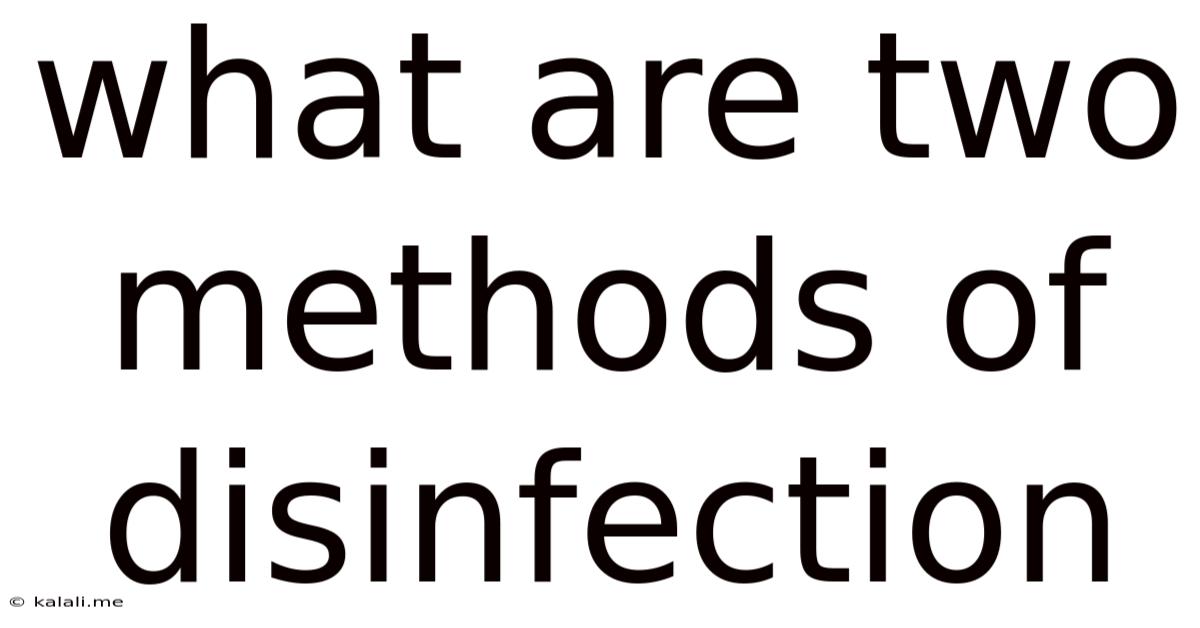What Are Two Methods Of Disinfection
Kalali
Jun 11, 2025 · 3 min read

Table of Contents
Two Effective Methods of Disinfection: A Deep Dive
Disinfection is a crucial process in maintaining hygiene and preventing the spread of infectious diseases. It involves eliminating or reducing harmful microorganisms like bacteria, viruses, fungi, and protozoa from surfaces, objects, or environments. This article will explore two widely used and highly effective disinfection methods: chemical disinfection and physical disinfection, detailing their mechanisms and applications.
Chemical Disinfection: Utilizing the Power of Chemicals
Chemical disinfection relies on the use of antimicrobial agents to kill or inhibit the growth of microorganisms. These chemicals target various components of microbial cells, disrupting their structure and function. The effectiveness of chemical disinfectants depends on factors such as concentration, contact time, temperature, and the type of microorganism being targeted.
Types of Chemical Disinfectants and their Applications:
-
Chlorine-based disinfectants: These are widely used for water disinfection and surface sanitation. They are effective against a broad spectrum of microorganisms, but their effectiveness can be reduced by organic matter. Examples include sodium hypochlorite (bleach) and chlorine dioxide. Note: Always dilute bleach according to manufacturer instructions.
-
Alcohols (e.g., ethanol, isopropanol): These are effective against a range of bacteria and viruses, particularly enveloped viruses. They work by denaturing proteins and disrupting cell membranes. Commonly used for hand sanitization and surface disinfection of non-porous surfaces.
-
Quaternary ammonium compounds (quats): These are low-toxicity disinfectants used in various settings, including hospitals and homes. They are effective against many bacteria and some fungi, but less effective against viruses and spores.
-
Hydrogen peroxide: A powerful oxidizing agent effective against a wide range of microorganisms. It is commonly used for wound care and surface disinfection, breaking down into water and oxygen after use.
Choosing the Right Chemical Disinfectant: The selection of a chemical disinfectant depends on various factors, including the type of microorganism to be eliminated, the surface to be disinfected, and safety considerations. Always follow manufacturer instructions carefully for appropriate dilution and application.
Physical Disinfection: Harnessing the Power of Physical Agents
Physical disinfection methods employ physical agents to eliminate or reduce microbial populations. These methods are often used in conjunction with chemical disinfection for enhanced efficacy.
Methods of Physical Disinfection:
-
Heat: Heat is a highly effective method for disinfection, with various applications based on the temperature and duration of exposure.
- Boiling: Boiling water at 100°C (212°F) for at least 10 minutes effectively kills most vegetative bacteria and viruses.
- Autoclaving: This high-pressure steam sterilization method is commonly used in healthcare settings to sterilize equipment and materials at temperatures above 121°C (249°F). It effectively eliminates all forms of microbial life.
-
Radiation: Ultraviolet (UV) radiation can be used to disinfect surfaces by damaging microbial DNA. UV disinfection is commonly used in water treatment plants and air sterilization systems. However, effectiveness depends on the intensity and duration of exposure and may not penetrate surfaces completely.
-
Filtration: This method is used to remove microorganisms from liquids or gases by passing them through a filter with small pores. It is effective in removing bacteria, viruses, and other particulate matter. This is often employed in water purification and air filtration systems.
Choosing the Right Method: The best disinfection method depends on the specific application and the type of microorganisms being targeted. Sometimes, a combination of methods offers the most effective solution.
Conclusion:
Both chemical and physical disinfection methods play vital roles in controlling microbial contamination. Understanding the strengths and limitations of each method is crucial in selecting the most appropriate technique for a given situation, ensuring effective disinfection and maintaining a safe and healthy environment. Always adhere to safety guidelines and manufacturer instructions when using any disinfection method.
Latest Posts
Latest Posts
-
How Many Slices Of Turkey In 2 Oz
Jul 01, 2025
-
Omnipoint Miami E License Llc Miami Fl
Jul 01, 2025
-
Mi Familia Fuera La M S Grande Correct Incorrect
Jul 01, 2025
-
How Much Is 20 Pounds Of Pennies Worth
Jul 01, 2025
-
How Much Does A Gallon Oil Weigh
Jul 01, 2025
Related Post
Thank you for visiting our website which covers about What Are Two Methods Of Disinfection . We hope the information provided has been useful to you. Feel free to contact us if you have any questions or need further assistance. See you next time and don't miss to bookmark.